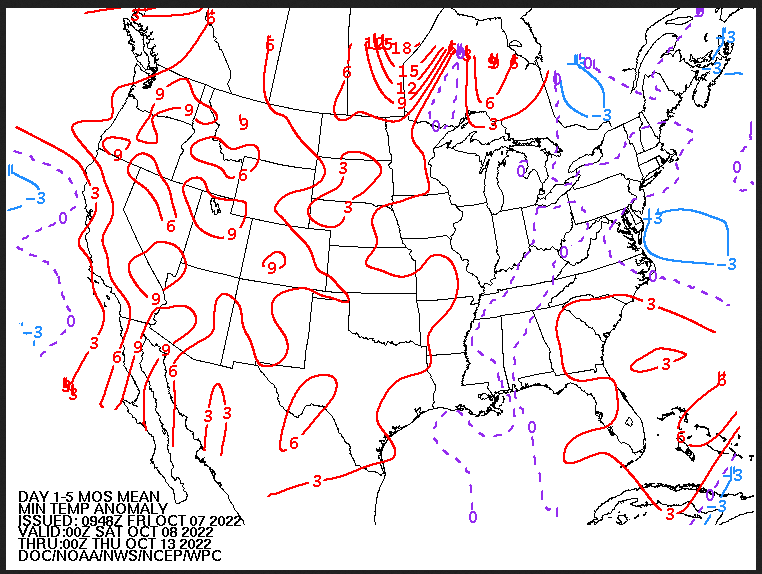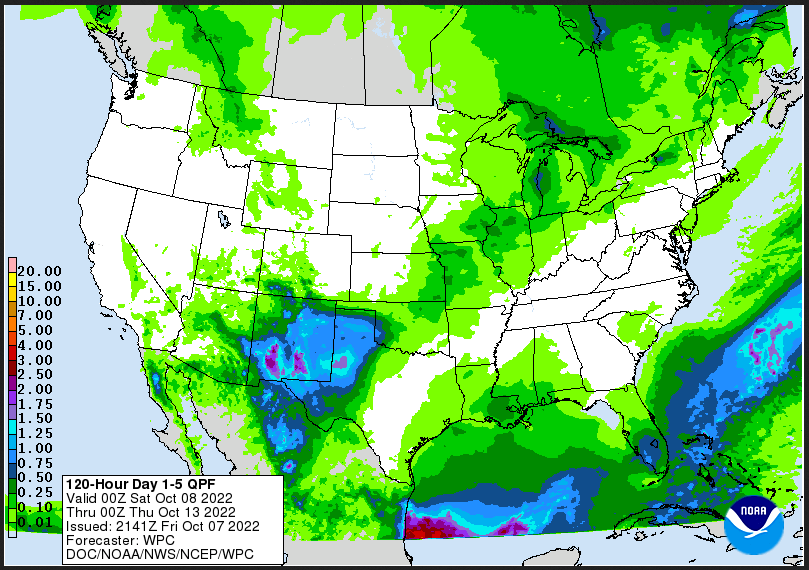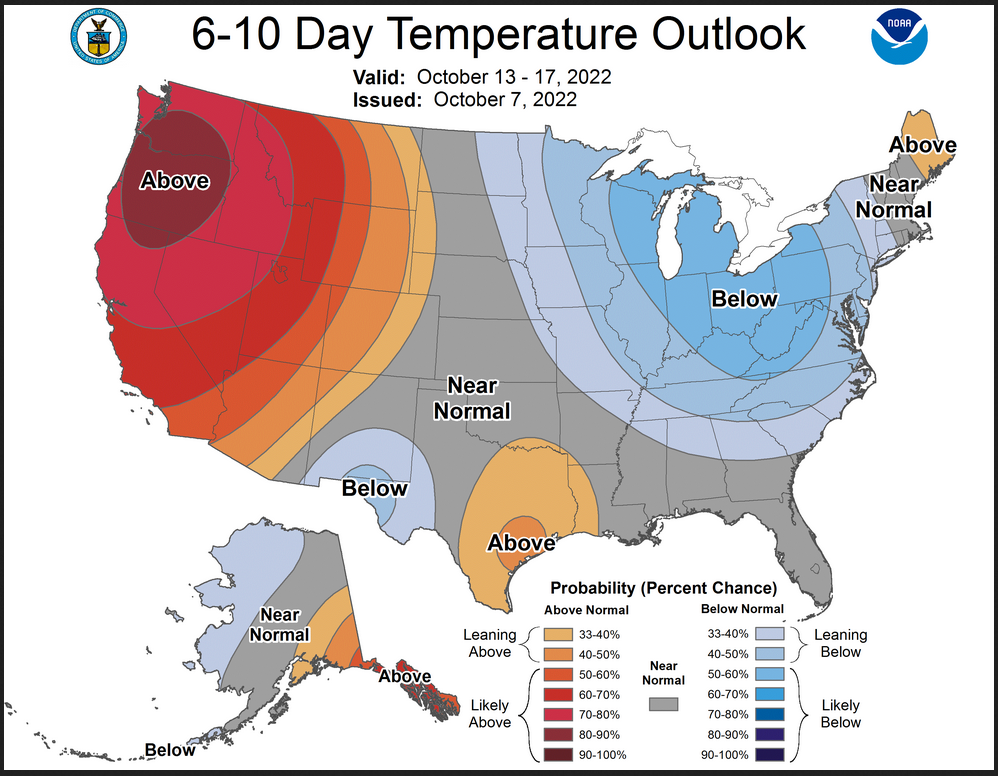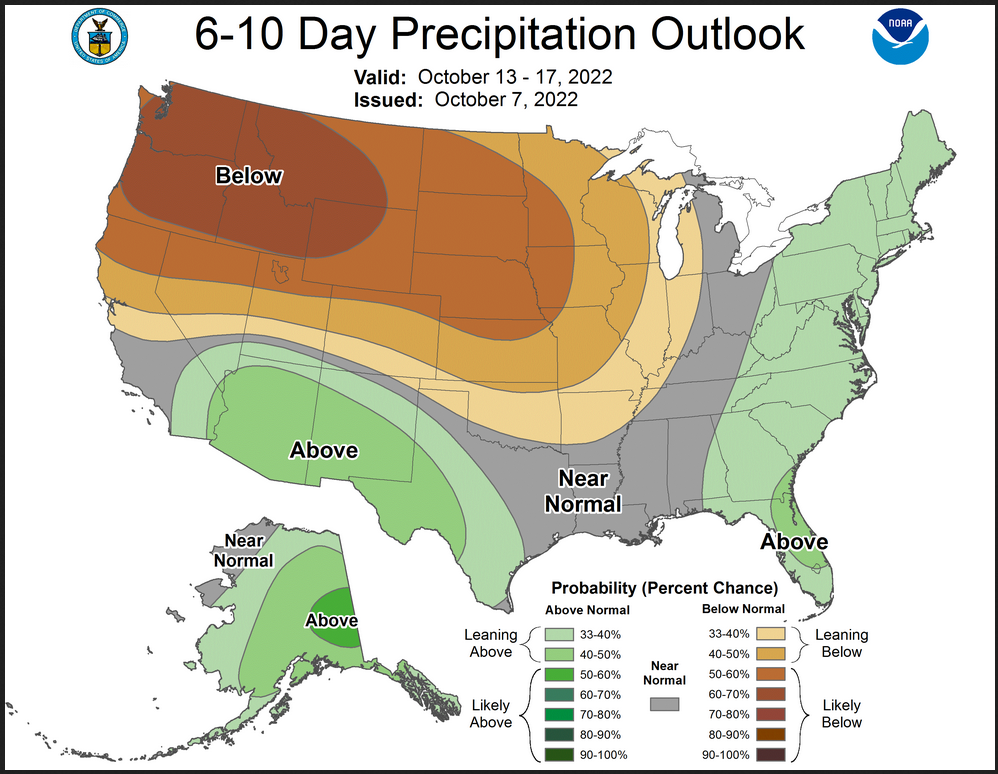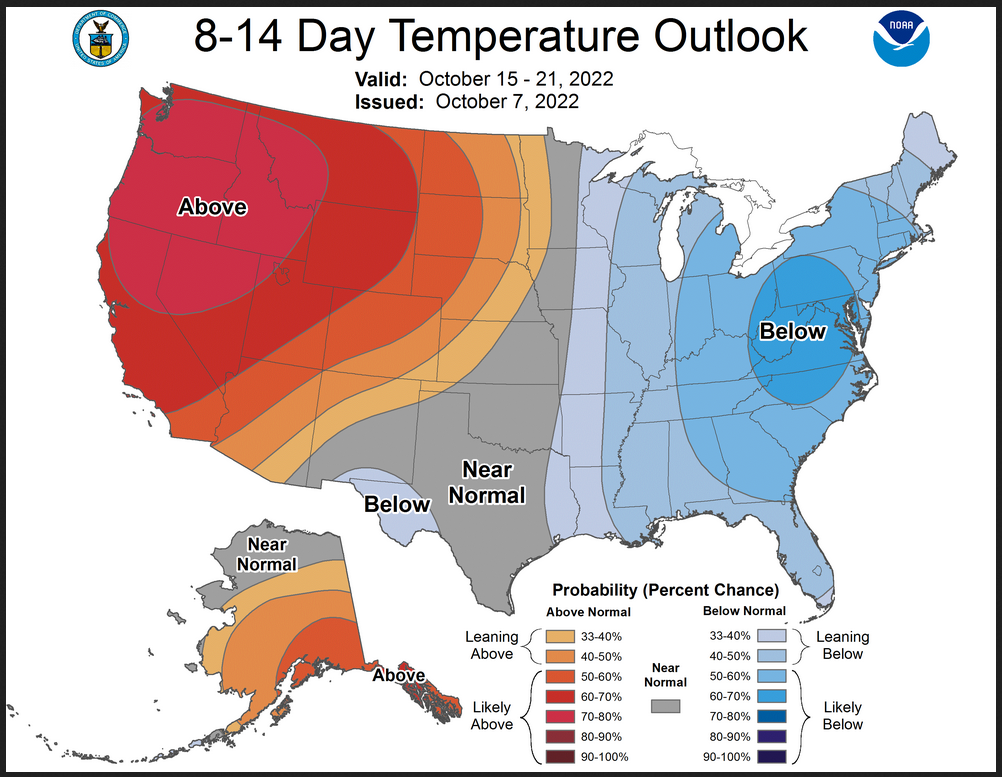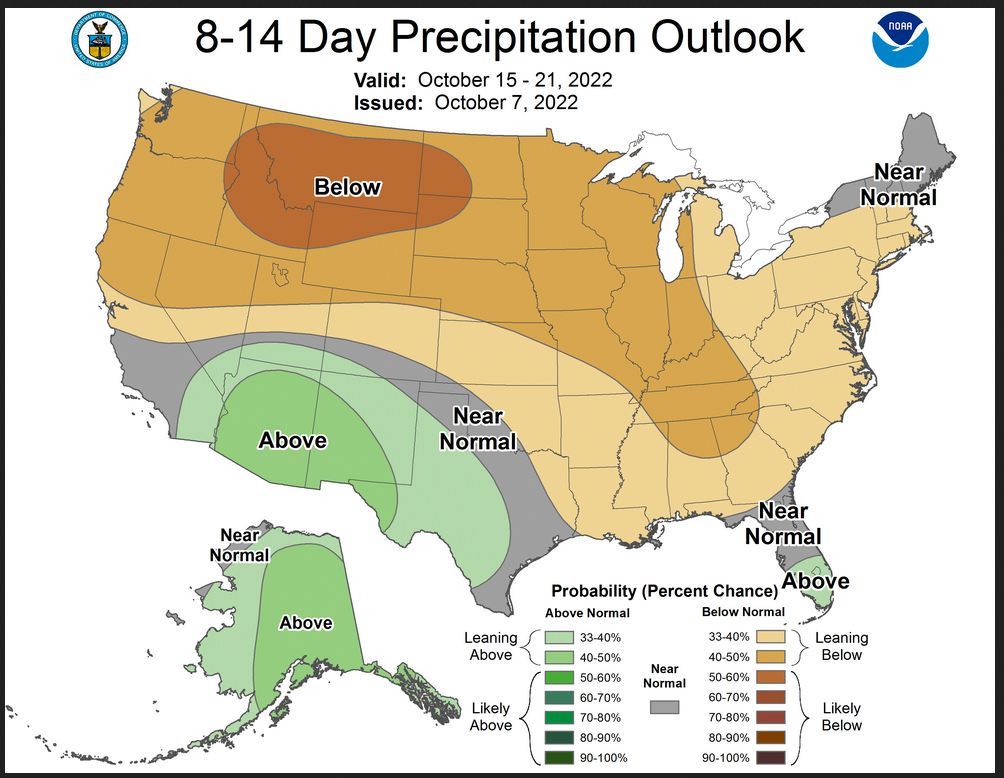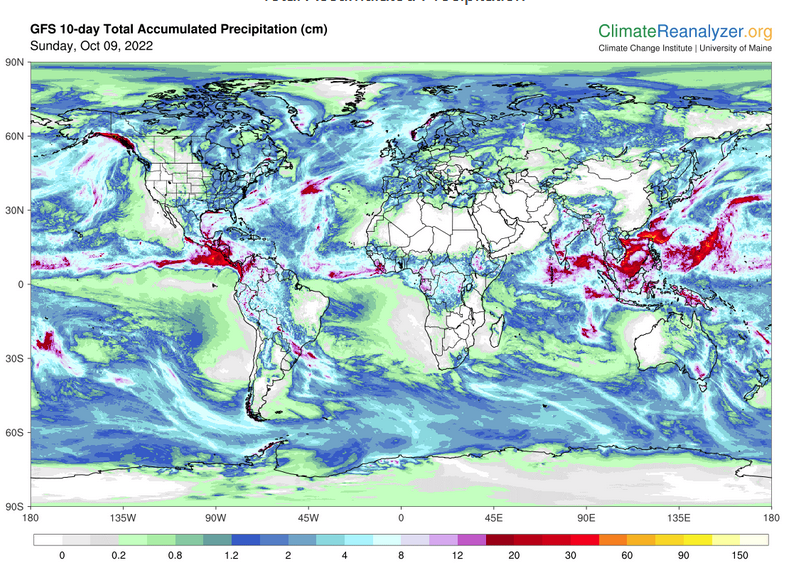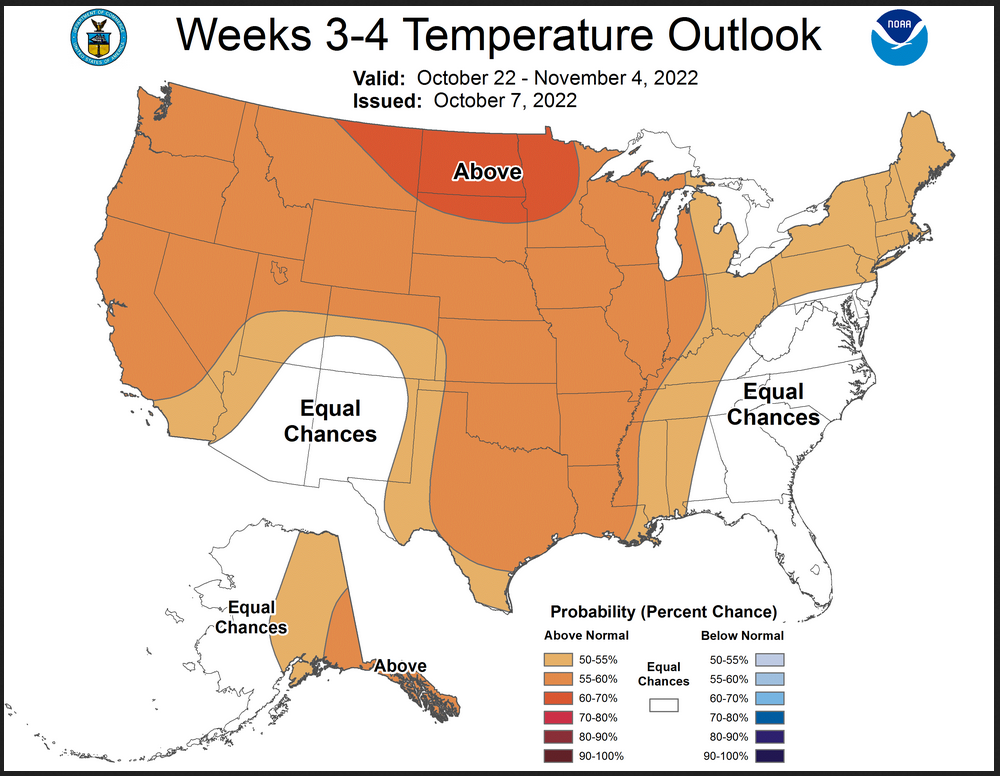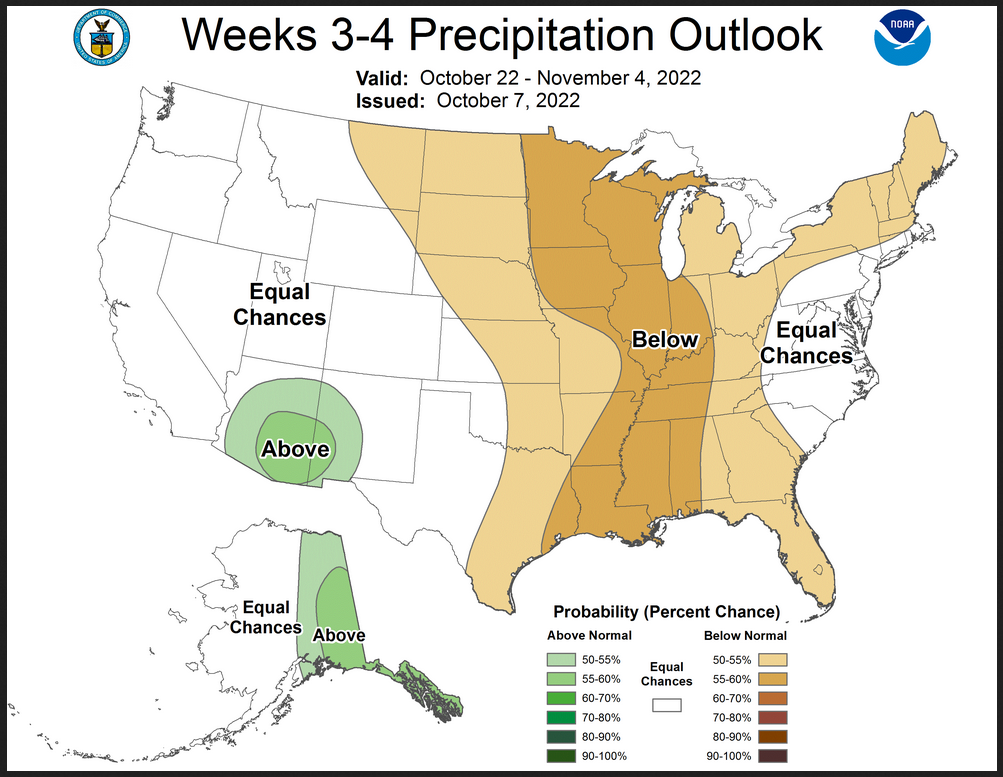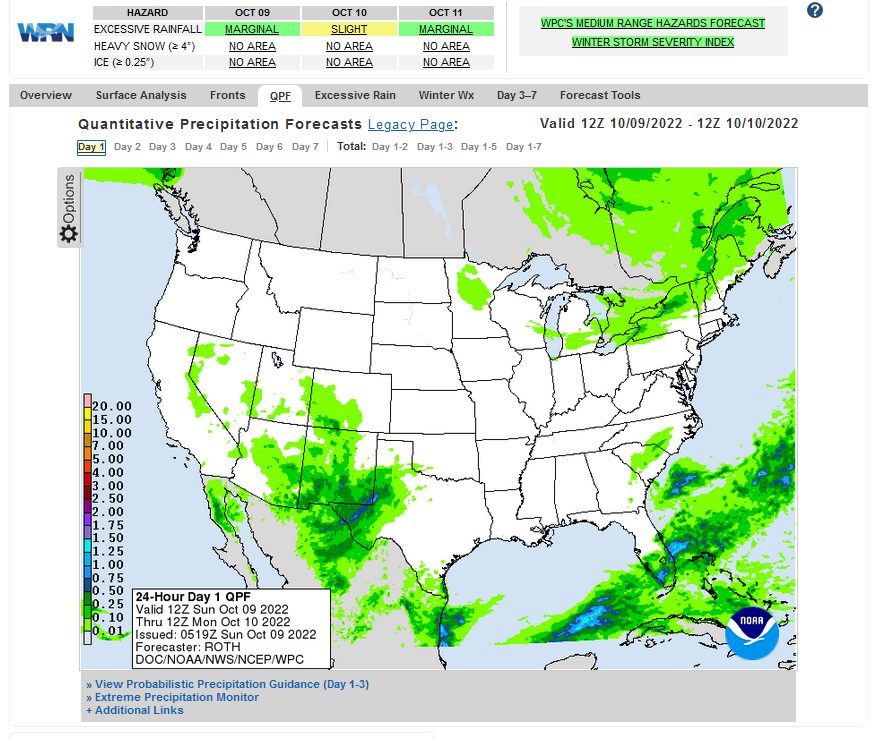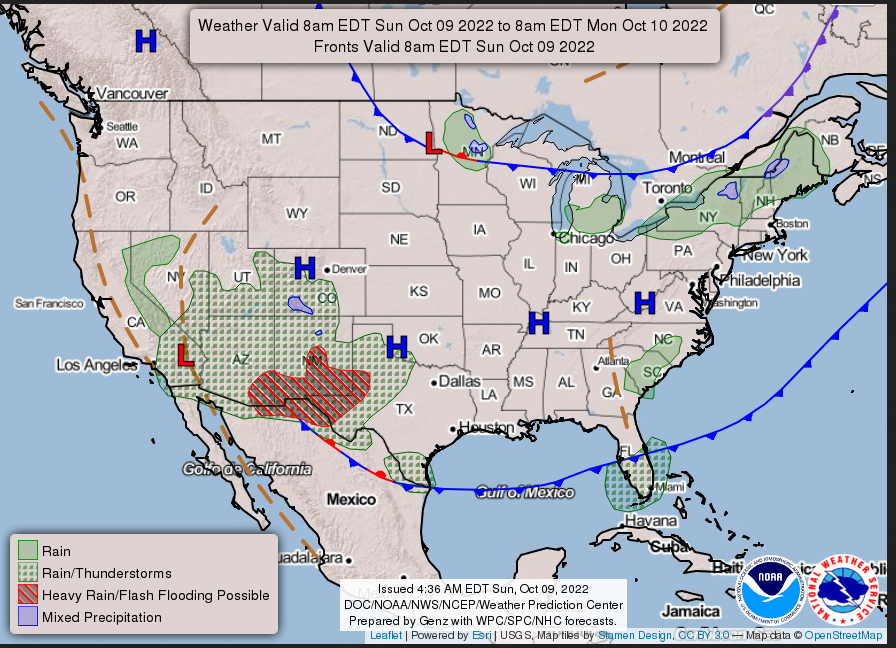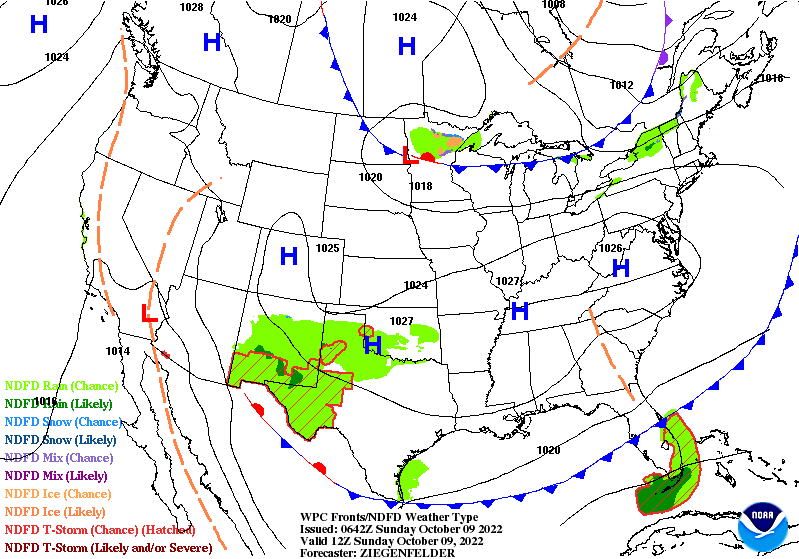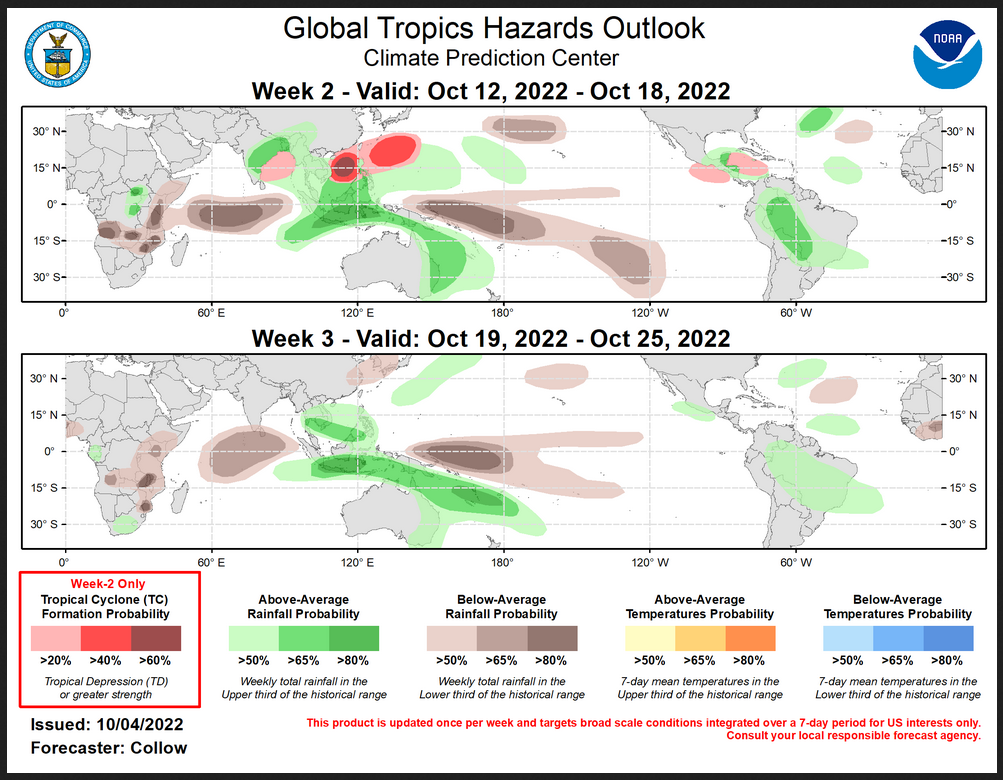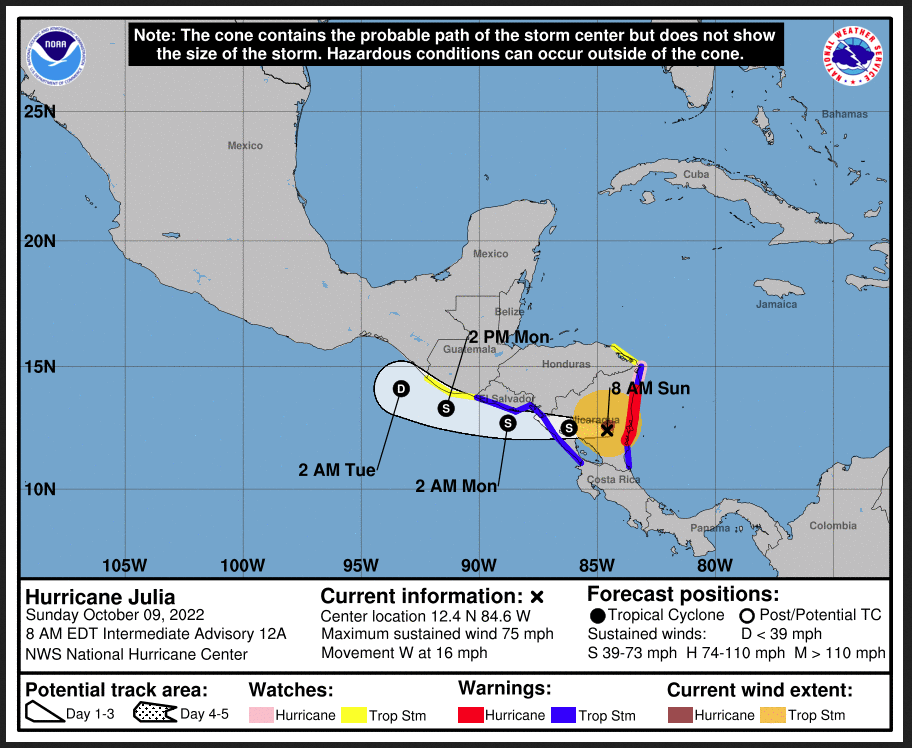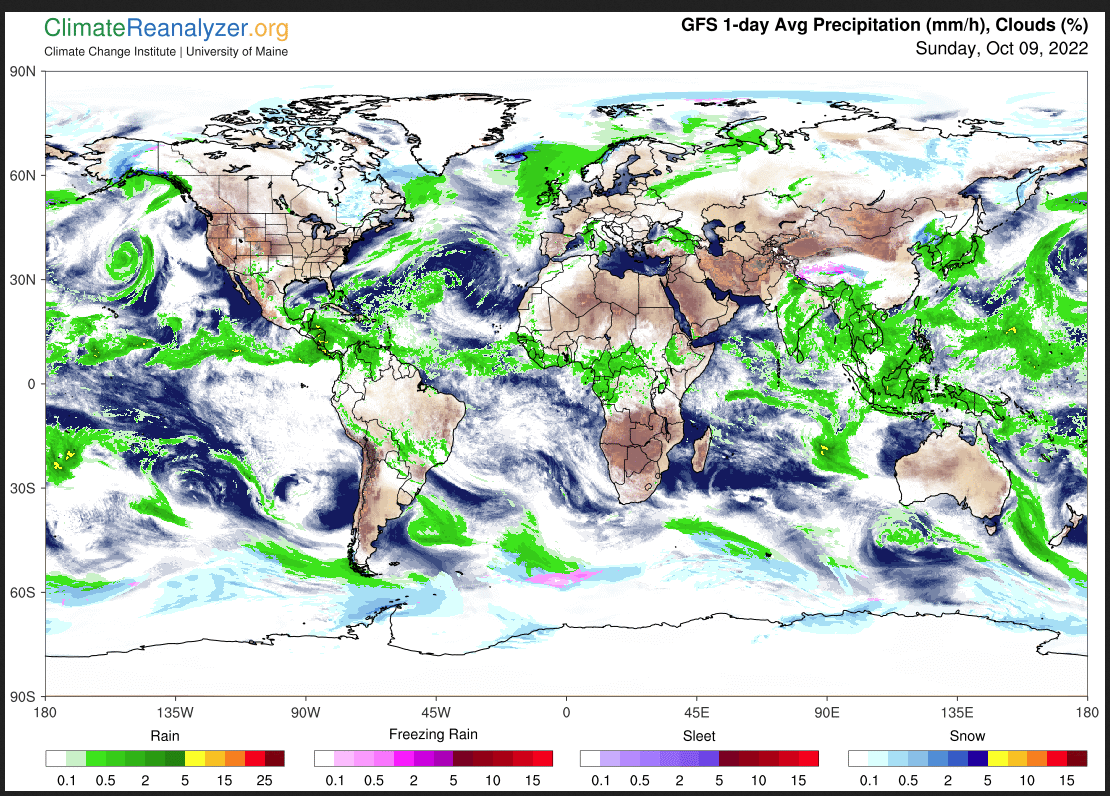Updated on October 9, 2022 at 10:30 a.m. EDT rather than publishing a new more abbreviated article today.
NOAA updates many of its weather outlooks daily or even more frequently and in many cases issues a discussion with those outlooks. We provide a daily report which focuses on the shorter-term predictions but also has links to all the partial-month outlooks. Because WordPress does not provide the ability to have these maps automatically updated, our daily report shows some of the maps which we update each evening plus the links to the other important weather forecast Maps.
Once a week we show many of the actual forecast maps not just provide the links to these maps. This makes it easier for the reader. Our report provides a separate forecast for Days1-5, Days 6 -10, Days 8 – 14, and weeks 3 and 4. This provides information that is useful to readers in terms of planning their activities for the next 28 days.
The week 3-4 outlook is only updated by NOAA’s Climate Prediction Service once a week on Friday. Thus, when we publish on Friday night, it provides a 28-day view of the future. What is important is that this is a longer-term view than one that is typically available in the media and online.
We also include In Part II of the article the other information from the daily 48-hour forecast article. Importantly, this time of the year, it includes updates on tropical events. In both Parts I and II we include some worldwide forecasts also. We also include tonight an interesting podcast that reviews the summer monsoon and discusses how the La Nina will impact Fall and Winter.
It is important to recognize that the forecasts do not always work out as predicted. But in the article, there are links to obtain updated forecasts If you read this article a few days or more after it is published. And there will be a totally updated version next Friday.

What NOAA is predicting for the next 28 days.
We will start with the short-term – It is up to date as of today. If you look at this article after today you can click the links to update (plus you will end up with a lot of additional information)
| Temperature (Maximum or Minimum Anomaly) for the next five days | Precipitation (Five days of cumulative precipitation) |
| https://www.wpc.ncep.noaa.gov/medr/me dr_mean.shtml | https://www.wpc.ncep.noaa.gov/qpf/day1-7.shtml |
| Warm in the West and cool and wet in the Southwest. Because we are getting into the first-frost season I used the minimum temperature departure graphic rather than the maximum temperature departure. I assume that what I am showing is the departure from the normal low for the five-day period. |
Now we look at “Outlook” maps for three time periods. Days 6 – 10, Days 8 – 14, and Weeks 3 and 4. An outlook differs from a forecast based on how NOAA uses these terms in that an “outlook” presents information as deviation from normal and the likelihood of these deviations.
I have provided the maps so you do not need to click to get them. But they do not update daily. But you can get the current images simply by clicking on the links provided. Then hit the return arrow at the upper left of your screen to return to the article. There is no need to do that right away since what is published today is up to date. The Week 3 – 4 Outlook only updates on Fridays.
Below are the links to obtain updates and additional information.
| The West is warm and the East is cool and much of CONUS is warm. The Southwest and East Coast are wet. |
| The pattern moderates a bit but expands. |
Let us take a look at the world situation. I think the units are centimeters.
Now we address Weeks 3 and 4. This is a time frame that is very important. It is half of the 28-Day forecast period. That is why we include the discussion that accompanies the maps.
Prognostic Discussion for Week 3-4 Temperature and Experimental Precipitation Outlooks
NWS Climate Prediction Center College Park MD
300PM EDT Fri Oct 07 2022Week 3-4 Forecast Discussion Valid Sat Oct 22 2022-Fri Nov 04 2022
La Niña conditions are currently present with below average sea surface temperatures (SSTs) across most of the tropical Pacific Ocean. Low-level easterly wind anomalies were evident westward from the east-central equatorial Pacific Ocean, while upper-level westerly wind anomalies were observed over the western and central equatorial Pacific. The Real-time Multivariate Madden Julian Oscillation (RMM) index indicates a weak intraseasonal signal during the last week. However, dynamical models depict a renewed MJO event emerging across the Maritime Continent and propagating into the western Pacific during the next two weeks. The Week 3-4 Temperature and Precipitation Outlooks are based primarily on operational dynamical guidance including the GEFSv12, CFSv2, ECMWF, JMA, and experimental guidance from the Subseasonal Experiment (SubX) multi-model ensemble (MME) prediction systems, with additional considerations for Madden Julian Oscillation (MJO) states, the El Niño Southern Oscillation (ENSO), decadal climate trends, and the evolution of the pattern from the Week-2 forecast.
Dynamical model 500-hPa height anomaly forecasts during Week 3-4 show a fairly consistent evolution from Week-2 forecasts. A blend of the CFSv2, ECMWF, JMA, and GEFSv12 500-hPa height pattern forecasts plus a contribution from the Multivariate Linear Regression (MLR) height forecast based on the RMM index, La Nina, and decadal trends, predicts anomalous ridging over the western Contiguous United States (CONUS), while anomalous troughing is forecast over the eastern CONUS. A deep trough and below-normal 500-hPa heights are predicted over the Aleutians, western Mainland Alaska, and the northeastern Pacific. Most dynamical models feature above normal 500-hPa heights over the Hawaii islands.
The Week 3-4 Temperature Outlook favors enhanced probabilities of near to above normal temperatures over most of the western and central CONUS and is consistent with a forecasted ridging pattern over the western CONUS. The highest probability of above normal temperatures (60-70%) are forecast for the north-central CONUS beneath a strong anomalous ridge. Weak troughing and slightly below normal heights lead to equal chances of above or below normal temperatures across most of the eastern CONUS except for the Northeast, where decadal trends and dynamical guidance support a tilt toward above normal temperatures. Onshore flow increases probabilities of above normal temperatures over eastern Mainland Alaska and the Alaskan Panhandle. Equal chances of above or below normal temperatures are indicated for western Mainland Alaska and the Aleutians.
The Week 3-4 Precipitation Outlook favors below median precipitation over most of the eastern two-thirds of the CONUS, supported by most of the dynamical precipitation forecast tools. Dynamical models favor weakly enhanced probabilities of above median precipitation over parts of the Southwest under near-normal 500-hPa heights and elevated soil moisture anomalies. In Alaska, a tilt toward above median precipitation is indicated over eastern Mainland Alaska and the Alaskan Panhandle ahead of a predicted trough over the Aleutians.
Above-average sea surface temperatures are currently observed in the vicinity of Hawaii.The SubX MME probabilistic temperature forecast favors strong probabilities of above average temperatures over Hawaii during the Week 3-4 outlook period. Dynamical model guidance from the SubX MME indicates slightly enhanced chances of drier than average conditions for Lihue and Honolulu and equal chances of above or below normal rainfall for Kahului and Hilo.
| It is important to note that the Week 3 -4 Outlook is prepared by a different team than the 6 -10 and 8 – 14 day Outlooks as well as the update of the monthly outlook. |
Climate Podcast.
We have a good one. Just click on the image to get the dashboard (or here and then click on the arrow on the podcast image. I am sure you will find the podcast Interesting.
Now switching over to Part II of this article which is our regular 48-Hr Forecast which also includes links for tropical updates and in some cases the NHC maps for storms that are near-term threats.
Here is what we are paying attention to today and the next 48 hours from this morning’s NWS Forecast.
Valid 12Z Sun Oct 09 2022 - 12Z Tue Oct 11 2022 ...There is a Slight Risk of excessive rainfall over parts of the Southwest, Southern Rockies, and western Texas through Monday morning... ...There is a Slight Risk of excessive rainfall over parts of the Southern High Plains from Monday into Tuesday morning... ...There are Frost Advisories and Freeze Warnings over parts of the Ohio Valley/Central Appalachians, Mid-Atlantic, and Northeast... Upper-level energy over Northwestern Mexico and a surge of moisture moving northwestward over the Southern Plains from the Gulf of Mexico will produce showers and thunderstorms with heavy rain over parts of southeast Arizona, southern New Mexico, and western Texas. Therefore, the WPC has issued a Slight Risk of excessive rainfall with these thunderstorms over parts of the Southwest, Southern Rockies, and far western Texas through Monday morning. The associated heavy rain will create mainly localized areas of flash flooding, with urban areas, roads, small streams, and burn scars the most vulnerable. On Monday, The threat of excessive rainfall moves slightly eastward to the Southern High Plains. Therefore, the WPC has issued a Slight Risk of excessive rainfall with these thunderstorms over parts of the Southern High Plains from Monday into Tuesday morning. The associated heavy rain will create mainly localized areas of flash flooding, with urban areas, roads, small streams, and burn scars the most vulnerable. Meanwhile, high pressure over the Mid-Atlantic, Tennessee Valley, and Southern Plains will move into the Mid-Atlantic and start to move over the Western Atlantic by Tuesday. The high pressure will produce clear skies and calm wind, allowing temperatures to go below or near freezing on Sunday morning. As a result, large parts of the Ohio Valley/Central Appalachians, Mid-Atlantic, and Northeast have Frost Advisories out until 8-9 AM local time. Furthermore, parts of the far Eastern Ohio Valley and Central Appalachians have Freeze Warnings out through 10 AM local time on Sunday morning. Moreover, the relatively cold air flowing over the relatively warm Great Lakes will produce lake effect rain showers downwind from Lakes Ontario and Erie through late morning Sunday. Furthermore, a front over Upper Midwest will move off the Northeast Coast by Monday morning while extending westward to the Middle Mississippi Valley. The boundary will aid in producing light rain over parts of the Upper Midwest on Sunday morning. In addition, light rain will develop along the front over parts of the Great Lakes into parts of Northern New England from Sunday afternoon into Monday morning. Additionally, a front moving onshore over the Pacific Northwest overnight Monday will move to the Northern High Plains by Tuesday. As a result, Rain will develop over parts of the Pacific Northwest into the Northern Rockies on Monday evening. By Tuesday, rain and rain/wet snow will be mostly over parts of the Northern Rockies/Northern High Plains. Elsewhere, a weak front and easterly flow off the Atlantic will allow showers and thunderstorms to develop over parts of southeastern Florida through Tuesday.
(It is updated twice a day and these updates can be found here.
Current forecast of heavy precipitation (Updates can be found HERE)
Maps that relate the forecast to geography can be found by clicking Here for Day 1 and Here for Day 2. (I will update these on Monday morning so they will be current at that point).
Here is a 60-hour animated forecast map that shows how the short-term forecast is expected to play out.
If it needs to be updated click here.
HAZARDS OUTLOOKS
Click here for the latest complete Day 3 -7 Hazards forecast which updates only on weekdays. Once a week probably Monday or Tuesday I will update the images. I provided the link for readers to get daily updates on weekdays. Use your own judgment to decide if you need to update these images.
Worldwide Tropical Forecast
(This graphic updates on Tuesdays) If it has not been updated, you can get the update by clicking here
Detailed Maps and Reports.
Below are four maps that summarize the situation for the Atlantic, Eastern, Central Pacific and Western Pacific. Additional information can be accessed by clicking H ERE
First the Atlantic
Click to view the forecast map and have access to additional information https://www.nhc.noaa.gov/gtwo.php ?basin=atlc&fdays=5
Then Eastern Pacific
Click to view the forecast map and have access to additional information https://www.nhc.noaa .gov/gtwo.ph p?basin=epac&fdays=5
Then Central Pacific
Click to view the forecast map and have access to additional information https://www.nhc.noaa.gov/gtwo.php?basin=cpac&fdays=5
And the Western Pacific
Click to view the forecast map and have access to additional information https://www.metoc.navy.mil/jtwc/jtwc.html
Updates and additional information can be accessed by clicking HERE
World Forecast
Below is the current or short-term precipitation forecast which can be updated by clicking HERE Additional maps for different time frames and other aspects of weather in addition to precipitation can be obtained HERE.
Month to Date Information
Temperature month to date can be found at https://hprcc.unl.edu/products/maps/acis/MonthTDeptUS.png
Precipitation month to date can be found at https://hprcc.unl.edu/products/maps/acis/MonthPNormUS.png
